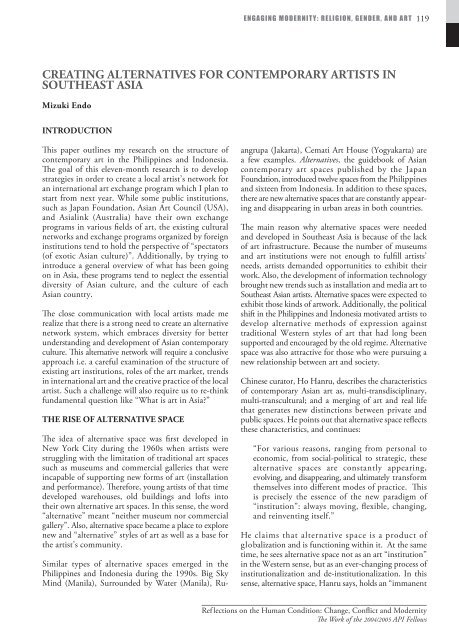Reflections on the Human Condition - Api-fellowships.org
Reflections on the Human Condition - Api-fellowships.org
Reflections on the Human Condition - Api-fellowships.org
Create successful ePaper yourself
Turn your PDF publications into a flip-book with our unique Google optimized e-Paper software.
ENGAGING MODERNITY: RELIGION, GENDER, AND ART 119<br />
CREATING ALTERNATIVES FOR CONTEMPORARY ARTISTS IN<br />
SOUTHEAST ASIA<br />
Mizuki Endo<br />
INTRODUCTION<br />
This paper outlines my research <strong>on</strong> <strong>the</strong> structure of<br />
c<strong>on</strong>temporary art in <strong>the</strong> Philippines and Ind<strong>on</strong>esia.<br />
The goal of this eleven-m<strong>on</strong>th research is to develop<br />
strategies in order to create a local artist’s network for<br />
an internati<strong>on</strong>al art exchange program which I plan to<br />
start from next year. While some public instituti<strong>on</strong>s,<br />
such as Japan Foundati<strong>on</strong>, Asian Art Council (USA),<br />
and Asialink (Australia) have <strong>the</strong>ir own exchange<br />
programs in various fields of art, <strong>the</strong> existing cultural<br />
networks and exchange programs <strong>org</strong>anized by foreign<br />
instituti<strong>on</strong>s tend to hold <strong>the</strong> perspective of “spectators<br />
(of exotic Asian culture)”. Additi<strong>on</strong>ally, by trying to<br />
introduce a general overview of what has been going<br />
<strong>on</strong> in Asia, <strong>the</strong>se programs tend to neglect <strong>the</strong> essential<br />
diversity of Asian culture, and <strong>the</strong> culture of each<br />
Asian country.<br />
The close communicati<strong>on</strong> with local artists made me<br />
realize that <strong>the</strong>re is a str<strong>on</strong>g need to create an alternative<br />
network system, which embraces diversity for better<br />
understanding and development of Asian c<strong>on</strong>temporary<br />
culture. This alternative network will require a c<strong>on</strong>clusive<br />
approach i.e. a careful examinati<strong>on</strong> of <strong>the</strong> structure of<br />
existing art instituti<strong>on</strong>s, roles of <strong>the</strong> art market, trends<br />
in internati<strong>on</strong>al art and <strong>the</strong> creative practice of <strong>the</strong> local<br />
artist. Such a challenge will also require us to re-think<br />
fundamental questi<strong>on</strong> like “What is art in Asia?”<br />
THE RISE OF ALTERNATIVE SPACE<br />
The idea of alternative space was first developed in<br />
New York City during <strong>the</strong> 1960s when artists were<br />
struggling with <strong>the</strong> limitati<strong>on</strong> of traditi<strong>on</strong>al art spaces<br />
such as museums and commercial galleries that were<br />
incapable of supporting new forms of art (installati<strong>on</strong><br />
and performance). Therefore, young artists of that time<br />
developed warehouses, old buildings and lofts into<br />
<strong>the</strong>ir own alternative art spaces. In this sense, <strong>the</strong> word<br />
“alternative” meant “nei<strong>the</strong>r museum nor commercial<br />
gallery”. Also, alternative space became a place to explore<br />
new and “alternative” styles of art as well as a base for<br />
<strong>the</strong> artist’s community.<br />
Similar types of alternative spaces emerged in <strong>the</strong><br />
Philippines and Ind<strong>on</strong>esia during <strong>the</strong> 1990s. Big Sky<br />
Mind (Manila), Surrounded by Water (Manila), Ru-<br />
angrupa (Jakarta), Cemati Art House (Yogyakarta) are<br />
a few examples. Alternatives, <strong>the</strong> guidebook of Asian<br />
c<strong>on</strong>temporary art spaces published by <strong>the</strong> Japan<br />
Foundati<strong>on</strong>, introduced twelve spaces from <strong>the</strong> Philippines<br />
and sixteen from Ind<strong>on</strong>esia. In additi<strong>on</strong> to <strong>the</strong>se spaces,<br />
<strong>the</strong>re are new alternative spaces that are c<strong>on</strong>stantly appearing<br />
and disappearing in urban areas in both countries.<br />
The main reas<strong>on</strong> why alternative spaces were needed<br />
and developed in Sou<strong>the</strong>ast Asia is because of <strong>the</strong> lack<br />
of art infrastructure. Because <strong>the</strong> number of museums<br />
and art instituti<strong>on</strong>s were not enough to fulfill artists’<br />
needs, artists demanded opportunities to exhibit <strong>the</strong>ir<br />
work. Also, <strong>the</strong> development of informati<strong>on</strong> technology<br />
brought new trends such as installati<strong>on</strong> and media art to<br />
Sou<strong>the</strong>ast Asian artists. Alternative spaces were expected to<br />
exhibit those kinds of artwork. Additi<strong>on</strong>ally, <strong>the</strong> political<br />
shift in <strong>the</strong> Philippines and Ind<strong>on</strong>esia motivated artists to<br />
develop alternative methods of expressi<strong>on</strong> against<br />
traditi<strong>on</strong>al Western styles of art that had l<strong>on</strong>g been<br />
supported and encouraged by <strong>the</strong> old regime. Alternative<br />
space was also attractive for those who were pursuing a<br />
new relati<strong>on</strong>ship between art and society.<br />
Chinese curator, Ho Hanru, describes <strong>the</strong> characteristics<br />
of c<strong>on</strong>temporary Asian art as, multi-transdisciplinary,<br />
multi-transcultural; and a merging of art and real life<br />
that generates new distincti<strong>on</strong>s between private and<br />
public spaces. He points out that alternative space reflects<br />
<strong>the</strong>se characteristics, and c<strong>on</strong>tinues:<br />
“For various reas<strong>on</strong>s, ranging from pers<strong>on</strong>al to<br />
ec<strong>on</strong>omic, from social-political to strategic, <strong>the</strong>se<br />
alternative spaces are c<strong>on</strong>stantly appearing,<br />
evolving, and disappearing, and ultimately transform<br />
<strong>the</strong>mselves into different modes of practice. This<br />
is precisely <strong>the</strong> essence of <strong>the</strong> new paradigm of<br />
“instituti<strong>on</strong>”: always moving, flexible, changing,<br />
and reinventing itself.”<br />
He claims that alternative space is a product of<br />
globalizati<strong>on</strong> and is functi<strong>on</strong>ing within it. At <strong>the</strong> same<br />
time, he sees alternative space not as an art “instituti<strong>on</strong>”<br />
in <strong>the</strong> Western sense, but as an ever-changing process of<br />
instituti<strong>on</strong>alizati<strong>on</strong> and de-instituti<strong>on</strong>alizati<strong>on</strong>. In this<br />
sense, alternative space, Hanru says, holds an “immanent<br />
Ref lecti<strong>on</strong>s <strong>on</strong> <strong>the</strong> <strong>Human</strong> C<strong>on</strong>diti<strong>on</strong>: Change, C<strong>on</strong>flict and Modernity<br />
The Work of <strong>the</strong> 2004/2005 API Fellows

















